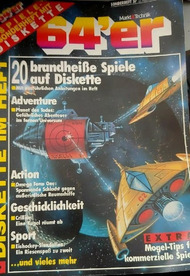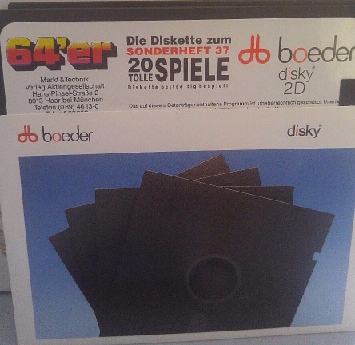[..] NEC launched this series in 1982, just one year after the PC-88, and supported both concurrently for a long time. […]
Show full quote
[..] NEC launched this series in 1982, just one year after the PC-88, and supported both concurrently for a long time.
Unlike the PC-88, the PC-98 was very PC-like, though not initially compatible with PC software, with an Intel processor, 128KB of RAM, floppy drives, and similar system architecture. A custom video card allowed 640x400 resolution (up from the PC-88's 640x200), which was enormous in 1982, albeit at only 8 colors. For comparison, the best equipped IBM PCs at the time could do 320x200 at 16 colors, or 720x350 in monochrome, and needed different hardware adapters and different displays for that. The PC-98's high resolution was important for rendering legible Japanese text, and having some color support was a big benefit to games, which often used dithering to simulate better color depth.
Like IBM, NEC offered new and improved models each year. By 1986, the PC-98 had a 286 processor, 3.5" floppies, 1MB of RAM, and 16 color support, which still surpassed IBM's EGA, due to a 4096 color palette, and also because 640x400 resolution was standard and widely supported, while most PC games remained at 320x200 even though EGA and VGA were capable of going higher.
By 1990, VGA was common in PC compatibles, which could easily match the PC-98's 640x400 16-color mode, or do 320x200 at 256 colors, and could switch modes on the fly. Also around this time, IBM released DOS/V, a DOS variant that could render Japanese text on these machines and run international software. The PC-98 was losing its advantage over PCs, and cost more to boot.
The 1992 model had 640x480 at 256 colors, which was equivalent to the most basic SVGA resolution. Other specs included a 386SX processor, 40MB hard drive, 1X CD-ROM, and 4MB of RAM, all of which was a bit to a lot out of date compared to the competition, which included the FM Towns, Sharp X68000, and numerous IBM PC compatibles. The system still had a dominant market share, but it was waning. NEC would partner with Microsoft to make a PC-98 compatible version of Windows 95, but this further eroded the system's relevance, as customers did not need a PC-98 to use Windows software. At this point, the PC-98 series just begins to look like another PC compatible, and it's not interesting to follow its specs until its final model in 2000, essentially a budget Celeron.
Thanks to its early market share, the system (like the PC-88) got a very large library of Japanese games, most of which are obscure outside of Japan, but some notable titles became better known through ports to other systems. KOEI is probably the most prolific developer of widely ported PC-98 games.
Select PC-98 titles:
A-Train
Dragon Knight 4
Genghis Khan
Knights of Xentar
Liberty or Death
Policenauts
Power Dolls
Princess Maker 1&2
Romance of the Three Kingdoms III: Dragon of Destiny
Romance of the Three Kingdoms IV: Wall of Fire
Uncharted Waters: New Horizons
Not listed are the numerous PC-88 games that were ported to PC-98.
(it's also the platform of origin of the Touhou Project series, but the early PC-98 entries are not well known and were never ported)
The standard high resolution mode also made it the system of choice for visual novels, including several notorious hentai games that got ported and localized over the years. Among them are:
Amy's Fantasies
Desire
EVE Burst Error
Fatal Relations
Gloria
Immoral Study 1&2
Nocturnal Illusion
Paradise Heights 1&2
Runaway City
Season of the Sakura
Three Sisters' Story
True Love
Source: https://gamefaqs.gamespot.com/boards/204-clas … gaming/76352712
Edit:
Does anyone know the reason for these differences? Was the Japanese hardware that much further ahead than the average US hardware at the time?
It was higher end. In the 80s, Japan's economy was at its height.
Money was available en masse.
That's why such incredible high-quality anime production was possible, too.
There's a saying that the hardware roughly was 10 years ahead of the time, compared to that of the west. They even had HDTV then (see MUSE system).
The first PC-98 had 640x400 in 8c (later 16c), but with two video processors.
One doing Kanji, one graphics combined via overlay.
The closest the Americans had at that time was the Tandy 2000 computer, which Windows 1.0 was being developed on.
In terms of IBM PCs, EGA and Hercules Plus (and InColor) were the earliest graphics cards on par with PC-98.
They matched it in terms of resolution and flexibility (soft fonts for text characters).
That's why DOS/V came to life.
It used VGA's mode 12h and programmable character generator ("VGA textmode").
This made it possible to display PC-98 games on DOS PCs.
The 640x400 16c graphics was being displayed within a 640x480 16c screen.
However, that doesn't exactly mean that VGA was superior through and through.
The two display processors (NEC µPD7220 VDp) in PC-98 were quite intelligent.
In fact, Intel had licensed this chip design.
It could haven used in western PCs, too.
https://en.wikipedia.org/wiki/NEC_%CE%BCPD7220
But the industry didn't adopt it.
The same way that 640x400 Enhanced CGA (Olivetti or AT&T) wasn't being adopted as a standard.
What's helding things back was the unwillingness to go beyond 200 lines.
Doing so would have required making and buying special CRT monitors that leave TV technology behind.
Like the MDA monitor, which is slightly beyond TV specs (18KHz vs 15 KHz, 350 lines vs 200 lines).
The lack of true EGA monitors in the retro community speaks volumes, I suppose.
While being rare, special monitors/high-resolution monitors nevertheless did exist in our hemisphere, in the form of multisync monitors.
They could handle a variety of resolutions and input signals (TTL mono, TTL RGB, analog RGB, CVBS etc).
But they usually weren't used by home users, but professionals.
Graphics workstations by say, SGI had used them.
Early 8514/A and SuperVGA users may had them, too.
And by the 90s, they became more popular, as Windows resolutions had been increased steadily.
_
Generaly speaking, in Japan, all of their business PCs had to handle complex characters, had to have high storage capacity (floppies),
the sound chips were same as found in middle class electronic keyboards. Not just beepers.
By contrast, we in the western hemisphere were using very primitive technology for most of the time.
Atari ST and Amiga could do manage 640x400 when focusing all of their power.
And our dinosaurs, the IBM PCs with Hercules graphics could do high-res graphics, at least.
Even if it was just monochrome and slow.
In the mid/late 80s, merely privileged users had access to multisync monitors and Super EGA/VGA cards with extended features.
Like 800x600 16c with 132 columns for text.
My Schneider Tower AT has such an on-board Super EGA chip, for example.
The PC was being made in West-Germany in 1988.
At its release, it was an top of the line system.
Edit: For the sake of fairness, I have to mention that some graphics cards could display higher resolution graphics on lower end monitors.
They've used interlacing or changed refresh rate accordingly.
That's how some ATI EGA Wonder cards could display EGA 640x350 on a normal video monitor (composite monitor).
There's also a Windows 3.0 driver patch (tweak) that can display 800x600 on a generic VGA card/VGA monitor.
It patches an Paradise VGA driver and uses 800x564 resolution. Monitor needs manual adjustment, I suppose.
Did the Japanese market just expect more from their games than Americans?
Uhm, well, I'm not sure. I'm European. 😅
Which doesn't make much of a difference, maybe. To them, we're all just "westerners", I believe.
Though the USA had an image of being especially cool and trendy in the 70s/80s.
While Europe was nothing but a tourist trap to them, I suppose.
Or an open air museum, hah. 😅
Anyway, thing is that to Japanese developers, the international market or USA market was not really a priority.
The Japanese island alone was such a big and prosperous market to them.
Similarly like the USA are whole world to their citizens.
The international business was rather done separately by their subsidiaries.
JAST had one called JAST USA, for example.
Edit: My bad, I misunderstood the question.
If you mean if there's a difference in sophistication between countries:
I think it was about different genres, also.
RPGs, maze crawlers, graphical adventures and side-scrolling shooters were a "thing" in Japan.
Visual novels, too, but they were rather late in the big picture (more complex graphic adventures with a parser had pre-dated them)..
Also popular were quiz/trivia games and board games, such as Mahjongg.
Or pachinko, a variation of pinball/flipper.
These games were usually featuring humorous, pretty or cutesy graphics, to visually appeal the audience.
While in the US, it were arcade and sports games.
Or poker games, golf sims, chess games.
MS Flight Simulator, Ford Simulator, SimCity..
The usual stuff. Not sure how to put it into words. There are so many things..
Text adventures with graphics and point&click adventures, for example.
Some of them were from Europe, also.
I'm just curious as to why these differences existed and why the improvements never made it back to the US in most cases?
Well, they kind of tried to make it back, I suppose.
The PC-98 processors V20/V30 are from NEC.
We mainly knew them ad cheap CPU upgrade chips.
But for some reason, the market wasn't ready for much else.
Except for video/entertainment technology, maybe.
Laserdisc, VHS, Sony Walkman etc.
In the US, it was all about IBM PC and Macintosh by the time.
While over here in Europe.. Oh, well, let's better don't talk about it. 😥
Edited.

